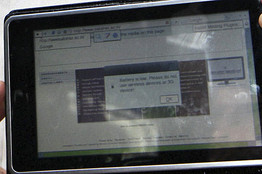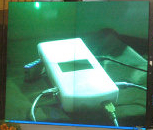Last week, India's Ministry of Human Resource Development (MHRD) announced a $35 tablet computer and listen to how The Wall Street Journal describes it:
"This is real, tangible and we will take it forward," Kapil Sibal, minister for human resource development, said at a press conference in New Delhi. The touchscreen tablet will cost about $35, or 1,500 rupees, when it hits markets by early 2011.
The device was developed by students and professors at India's premier technological institutes, using open-source programming, according to the Associated Press. The Indian Institute of Technology in Kanpur, Mumbai, Chennai and Kharagpur and the Indian Institute of Science in Bangalore researched it in collaboration with the government-operated National Mission on Education.
Before you start foaming for a $35 iPad, realize that this is another grand pronouncement from MHRD that follows a familiar path.
MHRD Proclamations in Context
Back in 2006, the very same Ministry of Human Resource Development claimed it was working on a $10 laptop and the The Times of India said that:
One official who attended the meeting said: " No one had any doubt about the feasibility of the project. Everyone is enthusiastic and wants a quick rollout. But we have given ourselves three years before the first $10 laptop comes out."
Exactly 3 years later, they revealed their $10 computer, and the Times of India described it thus:
The so-called laptop actually turned out to be a storage device containing megabytes of data info which can be accessed by a user by connecting this device to a laptop. It meant that unlike the internet, this device can display that information that has already been stored.
$35 Tablet Reality Check
I for one am tired of the vaporware announcements by India's Ministry of Human Resource Development. The much-hyped $10 computer was just a flash drive, and this tablet is a prototype cobbled together by students. So its nice to see the effort, but call me when you have a production line going and thousands of high-quality tablets for distribution.
Until then, go talk to OLPC India. At least they have tangible technology that can be scaled for India today.




There's a pretty good chance that this tablet already exists:
http://www.the-digital-reader.com/2010/07/23/more-details-on-indias-35-tablet/
I don't know for sure that they are the same, but they're close enough for me.
Just like Wayan I'll believe it when I see it in significant numbers and actually being available, not just a single prototype.
I just wonder if the $35 laptop has some of the basic features of OLPC or the XO laptop, such as for example:
1. Can a child use it in bright sunlight?
2. Will it survive the impact of a drop from FIVE Feet?
3. Can this be used in a pool of... water?
4. Does it follow the $10 laptop envisaged in 2008
The issues are simply as follows:
Can a government with all the will in the world create technologies that are useful for the end-user. They surely can trigger some creativity. But consumer technologies?
Why are the governments in general and MHRD in particular such a victim of Not Invented Here syndrome?
Why do they have to be in such a hurry that they ask people to contribute to creating a laptop on June 3, 2010 and unveil a "laptop" that looks like a tablet or ipad and has very limited functionality on July 22?
Why are they not able to even write the specs in 4 years since they began claiming that they would like to do it?
I understand that the minister got a free global publicity and his face was seen with a device he did not even understand the meaning of. Was that the motive for this media hungry minister?
Even if he wants to create a "nano" of laptops, what stops him from creating a transparent program and put a team together that learns all about making the best and cheapest laptop in the world?
Why not try out 100,000 OLPCs and then demonstrate why they do not work? And in the process learn all the secrets of OLPC? And get readier to create the next generation laptop?
One can go on and on.. But the most illogical route possible one is the one the minister chose. Seems like he has a thing for Negroponte?
India's MHRD minister should be taken to account for knowingly showing poor judgment in misleading the nation and the world with an announcement to make a $35 laptop that was never possible for anyone.
He was misled by his Jt Secretary N K Sinha who has been promoting the idea of a $10 laptop for several years. The last time he wanted to inaugurate it a major religious shrine and embarrassed India by displaying a device that may have been an embarrassment for high school kid in the US.
In his role to be on the board of IITs he has pushed a pliant professor by appointing him as a director of an IIT that is yet to be formed in any meaningful ways and the first task assigned to it was to helped develop a $35 laptop. Clearly this director was clueless about what to do.
The tablet shown by the Minister (and called a laptop??) was apparently procured from Taiwan at three times the price and then a plan was hatched to subsidise it by as much as necessary to make it available for $35 for college students.
MHRD tried asking several manufacturers in India to produce it but no one came forward. Those pressurized to do so wanted hefty subsidies. A newspaper with inside knowledge of the project quoted that the government wanted a guarantee for Rs 600 million for 100,000 laptops (tablets), implying thereby that the bill of material must have been at least Rs 6000 or $133 per laptop (tablet).
Producing even that has missed all the deadlines the Minister offered. He guaranteed that 100,000 students will have that laptop (tablet) by the 15th January, 2011. That was three months ago and till date MHRD has not even signed up any firm to produce it. Tenders have been scrapped a couple times.
All that such pronouncements have accomplished are postponement of decisions by the state governments and other state bodies by giving them wrong signals and a TV and media facetime for its MHRD minister who has moved up the endearment path to his bosses and got him several important public roles in turn.
But it has cost India's children dear. Is there an international commission to try people who deny children their future? Is UN listening?